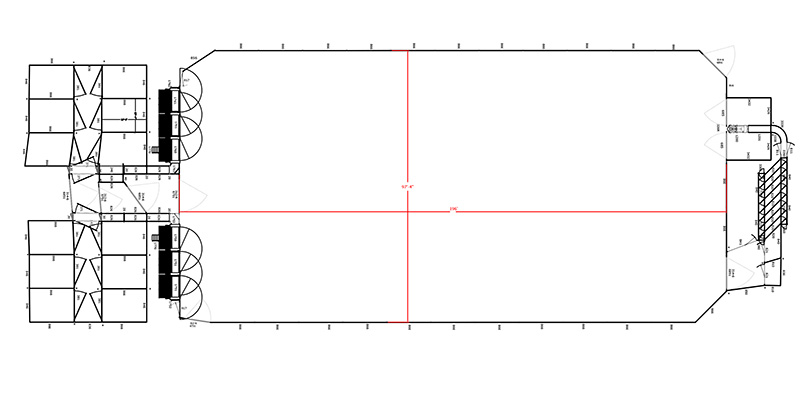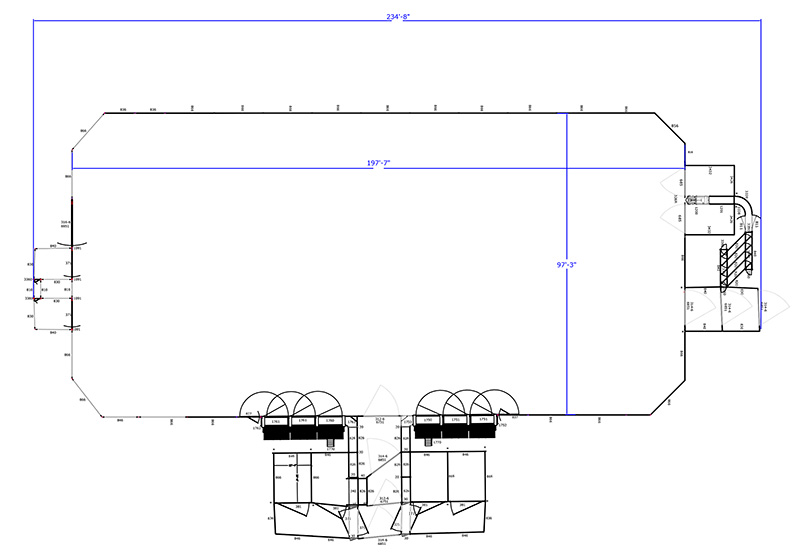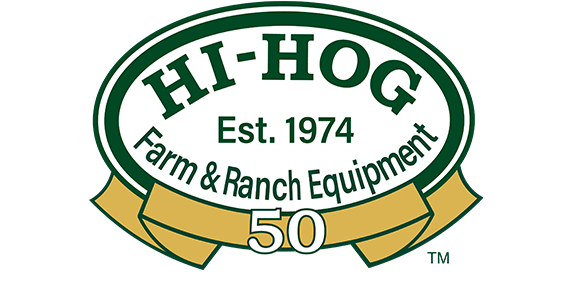Hi-Hog has designed and built hundreds of unique rodeo, ranching and riding arenas. Each design reflects the demands of the individual customer. The first question to consider is, “What events do you wish to host in your new rodeo arena?”
Below is a list of some of the rodeo events you may wish to host in your future arena. Each event has its own size standards. If you want to host a MULTIPLE EVENT ARENA, you need to ensure that the minimum standards are met for each of the rodeo events you are hosting.

Hi-Hog's Multi-Event 200' x 100' Rodeo Arena #1 (Long) (Open PDF)
In addition to the rodeo arena itself, you will need to consider if you require any specialized equipment such as bucking chutes, roping chutes, stripping chutes and loading chutes.
Other considerations:
- Do you require any pens for holding rodeo stock?
- Do you need to adjust the design to meet specific site conditions?
- Is your facility for public or private use?
- How can you organize all of these elements with appropriate gates and alleys to allow livestock and people to flow efficiently and safely through your facility?
Arena Types (use the links below to go directly to the sample arenas):
- Rough Stock Rodeo Arenas
- Saddle Bronc Riding
- Bareback Bronc Riding
- Bull Riding
- Timed Event Arenas
- Chuck Wagon Arenas
- Standard Chuckwagon Racing
- Mini-Chucks
- Ranching Events
- Other Arenas
- Pleasure Riding Arenas
- Dressage Arenas
- Reining Arenas
- Working Cow (Reigning Cow) Arenas
- Hunter/Jumper Arenas
- Driving Arenas
- Round Pens and Lunging Pens
Note: The size of your arena may vary with your intended purpose and use. For example, If you are training riders and horses for roping/steer wrestling events, you may want a wider and longer arena than would be required by a professional horse and rider. Additionally, if you may have several riders in the arena at any time, you may want a larger arena so those that are waiting are not interfering with those who are roping.

Hi-Hog's Multi-Event 200' x 100' Rodeo Arena #2 (Middle) (Open PDF)
ROUGH STOCK RODEO EVENTS often include several bucking events including saddle bronc riding, bareback bronc-riding and bull riding.
Hi-Hog’s rough stock arena’s feature their outstanding rodeo bucking chutes which can be ordered with left or right-hand exits. The modular design allows for flexible design as well as for easy facility expansion. Behind Hi-Hog’s bucking chutes you will find their rough stock stripping chute as well as an array of penning solutions to meet your rodeos stock needs. Hi-Hog also offers a wide range of heavy duty panel and gate options.
Whether you’re installing a permanent or a portable holding corral Hi-Hog's experienced design team can help you develop a plan that meets your requirements. Hi-Hog’s designers will also provide you with an accurate itemized quote.
Rough stock arena’s feature bucking chutes and bull stripping chutes.
NOTE: If you’re building a public facility you may also be interested in some of Hi-Hog’s other products including bleacher seating, picnic tables and fire rings.
Sample Rough Stock Arena 03 (Open PDF) (MOST REQUESTED)

Sample Rough Stock Arena 04 (Open PDF)

TIMED EVENT ARENA
Public rodeo facilities usually host many timed events, while clubs and individuals often request an arena for their individual timed event. These timed events may include:
- Calf Roping Arenas; also known as Tie down roping
- Team Roping Arenas; also known as heading and healing
- Steer Wrestling Arenas; also known as bulldogging
- Barrel Racing Arenas
Timed event arena’s feature roping chutes, roping boxes, calf stripping chutes, arrow sort pens and panels & gates.
Calf Roping/Tie-Down Roping Arena Designs
Calf Roping, also known as tie down roping, requires a horse and rider to work as a team. In this event, the rider speeds off after the calf, but only after the calf has broken the barrier of the roping box. After successfully roping the calf, the rider dismounts and runs down the rope to the calf, while his horse maintains tension on the rope. The cowboy then flips the calf onto its side or back and ties any three legs of the calf with a piggin’ string. While time is called when the legs have been tied the ride is not successful if the piggin' string does not hold for six seconds.
This is a team event that partners a cowboy with his horse. The skill of the horse to gauge the speed of the calf, stop at the right time, and hold the rope taught after the rider has dismounted is critical to the success of the cowboy.
Breakaway roping is another timed event based on the challenge of calf roping.
Sample Calf Roping Arena - 01 (Open PDF)

Sample Calf Roping Arena - 02 (Open PDF)

Team roping and steer wrestling use a similar arena design.
Team roping requires two riders, a header and a healer, to work together to rope a steer in the shortest time possible. The header ropes the head of the steer and the healer then ropes the rear feet. When both ropes are successfully thrown and drawn taught with the riders facing each other the time is called. The examples below use a 300' long arena. This length can be varied depending on the skill level of the participants.
Sample Team Roping Arena - 01 (Open PDF)

Sample Team Roping Arena - 02 (Open PDF)

Sample Team Roping Arena - 03 (Open PDF)

Sample Team Roping Arena - 04 (Open PDF)

Steer wrestling requires two riders as well. One rider acts as the hazer and is responsible for keeping the steer running straight while the second horse runs past the steer. As the second horse passes the steer the rider leans out from his horse and grabs the steer by the horns before dismounting. Upon dismount the cowboy digs his heels into the dirt in an attempt to slow the steer down. When the steer has been stopped the bulldogger then shifts his left hand under the steers jaw and wrestles the steer to the ground. When all four feet of the steer are off the ground and the steer is laying on his side the clock is stopped.
Steer wrestling arena would be similar to the team roping arena.
Barrel racing is a timed event that combines the horse’s athletic ability and the horsemanship skills of a rider in order to safely and successfully maneuver a horse through a clover leaf pattern around three barrels and cross the finish line.
PROFESSIONAL BARREL RACING STANDARDS:
- A minimum of 15’ between barrels one and two and the side fence (20' standard)
- A minimum of 30’ between barrel three and the back fence
- A minimum of 30’ between the time line (start/finish line) and the first barrel (60’ standard)
- Stopping distance can be no less than 45’ from the time line (60’ recommended)
- 90’ from barrel one to barrel two
- 105’ from barrel one and two to barrel three.
NOTE: If your barrel racing arena will be used by novice racers ensure that you provide generous distances between the barrels and the fence and between the time line and the fence. See sample below that shows the minimum, and standard barrel racing arena dimensions. Also shown is an expanded arena that provides a larger safe zone between the barrels and the arena fence, which is better for those learning to barrel race.
Sample One - Barrel Racing Arena - Minimum Dimensions (Open PDF)

Sample Two - Barrel Racing Arena - Standard Dimensions (Open PDF)

Sample Three - Barrel Racing Arena - Learning Arena Dimensions (Open PDF)

NOTE: (see drawing below) The barrel racing pattern can be scaled down for smaller arenas. Evaluate the skill level of your riders and set your safe barrel-to-side fence dimensions first (S). To get the distance between barrel one and two simply multiply the barrel-to-side fence dimension by two, and subtract this value from the overall width of your arena (Y). The distance between barrel one and barrel three (B) should be no greater than the distance between barrel one and two (A) plus 20 feet.
Sample Four - Barrel Racing Arena - Adjusting dimensions for small arenas (Open PDF)
Note: if you are using a short arena you may be able to place a gate at one end to allow riders to start and stop outside of the arena. The riders should still be provided safe footing and a safe distance to start/stop outside of the arena.
Sample Five - Barrel Racing Arena - Include a run out alley for short arenas (Open PDF)

Rodeo arenas can vary widely both in size and in program requirements. The more events you wish to host the more complex the arena design is likely to be. For example, arenas designed for a variety of events usually require more complex penning solutions to efficiently control both the variety of stock, as well as the potential for multiple stock suppliers.
The success of a public rodeo arena often depends on how safely and efficiently you can hold and move your livestock. This is particularly true if your rodeo is an event where spectators have paid to see a show. Your spectators don’t want to be kept waiting while you struggle to get the correct animal into the correct chute.
Sample One - Multiple Rodeo Event Arena (Open PDF)
 Multiple Rodeo Event Arena (Open PDF)
Multiple Rodeo Event Arena (Open PDF)
 Multiple Rodeo Event Arena (Open PDF)
Multiple Rodeo Event Arena (Open PDF)

Multiple Rodeo Event Arena With Bleachers (Open PDF)
This sample includes Hi-Hog's bleacher seating stands.

Every Hi-Hog’s rodeo arena is designed specifically for the individual customer and the individual arena site.
Every site is different. Here are a few questions for your consideration.
- How big is the site?
- What are the safe minimum width and length for each event you plan to host?
- Are there any existing structures or physical restrictions?
- Where will the public access your site?
- What are your public seating requirements?
- Where will the animals access the site?
- Do you require livestock loading facilities?
- What are your stock penning requirements?
- Will stock providers need their own pens?
- Will your stockman be on foot, or on horseback?
- Do you want a return alley for your timed events?
- Will you be holding stock overnight?
- What events do you plan to host?
- Do you want your roping chute at a particular end of the arena?
- Do you need to accommodate additional infrastructure, such as announcer stands?
- Do you require Hi-Hog to supply posts?
Ranching events refers to several contests that have emerged from practices performed on the cattle ranch. These events include team penning, ranch sorting, and cutting horse events. Each of these events require specific arena designs. Depending on your plans you may also require penning to hold your livestock.
Team Penning tasks three riders with cutting out three specific cattle from a group of thirty head and driving them down the arena away from the herd and guiding them into a 16′ x 24′ pen. This is a fast paced event that requires coordination between riders and their horses.
The ideal team penning arena is 200' x 100' in length. Locating the pen line and start/foul line is up to the event management or promoter and depends largely on the size of the arena your event will be held in. The line positions are referenced as a percentage of the arena's length. If the arena is longer than 200' the management may position the start/foul line closer to the cattle end of the arena.
Arena's wider than 100' are not recommended as it becomes more difficult for the competitors to control and contain the livestock.
The United States Team Penning Association (USTPA) and the Canadian Team Penning Association (CTPA) suggest different standards for placing the start/foul line.
Team Penning Links:
Sample Team Penning Arena - 01, The Ideal Arena (Open PDF)

Sample Team Penning Arena - 02, With 30 head group penning (Open PDF)
The number of pens you will require depends on a couple of things; the number of competitors, and the number of runs management wants to have with each group before a fresh group is brought in.

Like team penning, the origin of ranch sorting began on the ranch. This challenge tests a rider, or team of riders, ability to separate and move cattle from one pen to another in a specific order.
The size and scope of the ranch sorting arena depends on the purpose of the sorting pens. Practice pens do no likely require holding pens for the stock, while competitive sorting pens often do. Additionally, the size and shape of these pens may vary.
For competition, the pens are normally 60′ in diameter. the opening between the pen may also vary with the opening being larger with more riders on a team. The normal opening for a two-man team is 12′ wide. Some participants prefer round pens while others prefer pens with chamfered corners (like a stop sign).
Sample Ranch Sorting Arena - 01 (Open PDF)

Sample Ranch Sorting Arena - 02 (Open PDF)

Sample Ranch Sorting Arena - 03 (Open PDF)

Sample Ranch Sorting Arena - 04 (Open PDF)

Sample Ranch Sorting Arena - 05 (Open PDF)

Like team penning and ranch sorting, cutting focuses on skills utilized on the ranch. This event focuses not on time but on technique.
The horse and rider select a steer or heifer out of a small group and separates it from the herd. The rider then loosens the reins and the horse takes over. This event celebrates the talents of the horse as it works to keep the steer or heifer away from the herd without the guidance of the rider.
Cutting is often performed at one end of an existing arena. The cutting pens shown here are typical of a practice pen. Some riders prefer square corners over curved corners as livestock tend to follow the fence line in a pen with curved corners.
Cutting Horse Links
Sample Cutting Horse Arena 01 (Open PDF)

Sample Cutting Horse Arena 02 (Open PDF)
Arena’s come in a number of sizes depending on your intended use and budget. To assist you in your selection here are some of the standard arena sizes:
- Pleasure Riding Arena: 60′ x 120′
- Small Dressage Arena: 66′ x 131′ (20 m x 40 m)
- Large Dressage Arena: 66′ x 197′ (20 m x 60 m)
- Reining Arena: 100′ x 200′ minimum, 150′ x 300′ better
- Working Cow (Reigning Cow) Arena: 60′ x 120′ min, 75′ x 165′ better. If the arena gets too wide (over 100′) or too long (over 280′) the arena will be less suitable for this event
- Hunter/Jumper Arena: 150′ x 300′, bigger would be better. The arena size will depend greatly on the class of jumpers and the course design that you will be hosting
- Driving Arena: 130′ x 260′
- Round Pens and Lunging Pens. Round Pens tend to have a diameter of 50′ to 60′. Follow this link for more information on Hi-Hog’s round pens.
For further assistance contact Hi-Hog.

